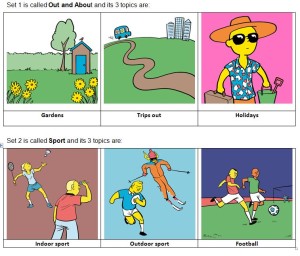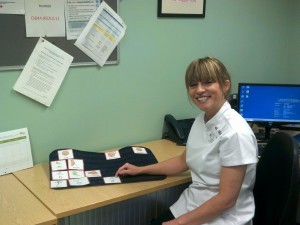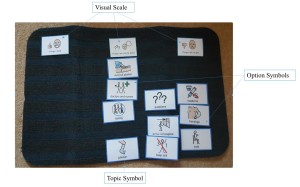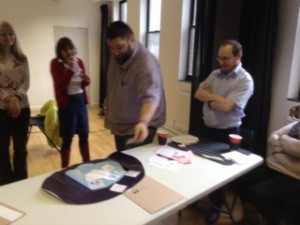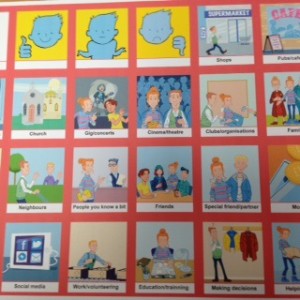A conversation is an informal interaction, between two or more people, in which news and ideas are exchanged. Having a conversation can be an enjoyable activity for people and is an important part of socialisation but is often hard for people with communication difficulties to take part and hard for families, friends and staff to support these informal conversations as well as finding topics to talk about. We have developed a range of Talking Mats symbol sets called Conversation Topics which can be used by people of all ages and abilities to take part in conversations and have a chat.
These are now available to anyone who has completed a Talking Mats training course.
Each Conversation Set is made up of 3 topics with specially designed symbols. Click on the image to enlarge.
Examples of how this resource has been used during our pilot phase:
Gardens: A resident in a Care Home chatted about what she liked and didn’t like about the Care Home gardens and made some suggestions for changes.
Trips Out: A group of people at a Day Centre planned where they wanted to go for their weekly outings.
Holidays: A young man with a learning disability talked to his social worker about where he had gone on holiday and what he had enjoyed.
Indoor Sports: A woman with a stroke chatted with her friend about the sports she wanted to try at the local Sports Centre.
Outdoor Sports: A man with dementia talked about the sports he used to do when he was younger.
Football: A group of people with learning disability chatted about what they liked and did not like about a football game they watched on TV. This set provoked lots of lively discussion.
Keep a lookout for further sets in the future.
If you have completed a Talking Mats training course and would like to order these sets please contact info@talkingmats.com or phone 01786 479511
Other resources to expand your use of Talking Mats can be found on our website – www.talkingmats.com.
Many thanks to Nicola Lewis from London who has sent us this powerful blog. She has 2 roles – one as a Registered Intermediary with adults with learning disabilities and the other as a family mediator working with children.
I started work as an intermediary, assisting vulnerable people to communicate their evidence to the police and in court. I work with adults with a mild to moderate learning disabilities or mental health issues and with children. The Talking Mats tool has proved invaluable, initially as a rapport building exercise which enables me to build a connection with the person. At the same time I can assess their communication in an informal way. I notice that it is often a relief for those who don’t want to talk as they can just engage in moving the pictures around, without having to make eye contact or without having to speak.They do often start chatting, in spite of themselves as there are not many people who don’t like to talk about their likes, dislikes and preferences and to be heard about what is important to them. I use active listening: reflecting back what they say, summarising, reframing and a touch of humour if appropriate to build a connection, using the mat. When they see me the next time, they often remember me in connection with the Talking Mat:”oh yeah, we did that picture thing!”
I also work as a family mediator and have a specialist qualification enabling me to meet with the children of the family to discuss their wishes and feelings. Again, the Talking Mats tool is the first thing out of my bag and on the table. After working through likes and dislikes in a natural and informal way, I can then use the cards with the children and ask about “your family”, “where you live” etc to find out about how they are managing in a divorce situation and what they might want their parents to know about their feelings. Many mediators will only meet with older children. The Talking Mats tool has given me access to the thoughts of those as young as 5. They are at ease with me and there is a level of trust that did not exist when they entered the room.I have had 100% positive feedback from these meetings as a result.
Thanks for developing this amazing tool. It is incredibly useful to me in both my roles.
Please send us any other stories you would like to share
Thanks to Gill Pearl for sending us this information about an international conference for people with aphasia.
Where: Warwick Conference Centre, Coventry, England
When: Sunday 5 and Monday 6 March, 2017
Families, friends, aphasia and stroke organisations, and health professionals are also invited. People with aphasia have planned the conference and will chair the sessions.
The information will be presented in a way that is easier for people with aphasia. There will be support from therapists and students to help people to join in.
The following themes will be discussed
- technology and aphasia, learn and have a go
- increasing awareness of aphasia, and using social media
- sharing what’s happening about aphasia around the world
- research
- support for carers of people with aphasia
- aphasia and the arts.
There will be an exhibition of products relevant for people living with aphasia
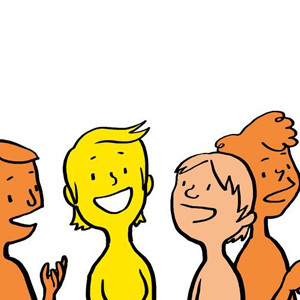
- Do something new, develop confidence, be inspired
- Learn from each other and share ideas
- Find out about new services and ways to help
- Meet people with aphasia from around the world!
If you want to find out more, contact Gill or Denise at
- info@buryspeakeasy.org.uk
- gill@buryspeakeasy.org.uk
- 01706 825802 (part time office)
We are delighted to be travelling to Australia and New Zealand in May 17 and look forward to the opportunities the trip gives us to discuss Talking Mats in these countries.
Firstly, we are pleased to have been invited over to Australia to be involved in the Agosci Communication Conference in Melbourne from the 18-21 May 2017. Agosci is an inclusive organisation that supports the participation of all people with complex communication needs. The theme of this conference asks participants to involve people with complex communication needs in all aspects of life to create a more welcoming society for people with communication support needs.
Lois and Nicki will be attending for Talking Mats and their involvement at the conference includes
- A one day pre – Agosci conference Foundation training for professionals in Melbourne
- 2 presentations – one on the potential use of Talking Mats in National Disability Insurance Scheme (NDIS) and one on our current Keeping Safe project
- A poster on using Talking Mats in Eating and Drinking
- A stand which will run throughout the conference and where we can and meet and chat to delegates
In addition prior to the conference we are running
- A one day Foundation training in Sydney for Hammond Care
New Zealand
Plus we are really pleased to have linked with the Talk Link trust in New Zealand and will be visiting both Christchurch and Auckland and running foundation courses in both those places. New Zealand can be proud of their world record of electing Robert Martin in June 2016 to become the first person with an intellectual disability to serve on the UN committee dealing with people with disabilities. It feels a privilege going to a country which is providing such leadership in self-determination.
Train the trainers
We fly back to Melbourne and run a two day Accredited Training in St Kilda’s Melbourne for Australian and New Zealand professionals previously trained in the use of Talking Mats via our online course. This course will allow them to train others within their respective organisations. By providing our accredited training and ‘training the trainers’ we are facilitating the increased use of Talking Mats in Australia and New Zealand . This increases professional skills, improves the quality of the service being provided and most importantly improves the quality of life of the person with the communication difficulty by assisting them to express their views.
So a busy schedule but exciting and we hope to have some time off to relax and enjoy new sites and a different culture. There will be more blogs to follow……… Plus if anyone has any top tips for coping with long distance flights we would like you to share them!
Many thanks to Cheryl Strutt for this lovely blog about how she developed and used an Aromatherapy Talking Mat with people with learning disability.
I am an Aromatherapist who works with adults who have a learning disability and often additional communication difficulties. As part of a recent service review I wanted to develop patient involvement. Talking Mats (TM) was suggested as a possible option to support patient feedback. I decided to look into this tool further and access training. During my TMs training I was supported to develop my specific Aromatherapy TM. The main aim behind this initiative was to adopt a system that could identify how each patient felt about the service and identify if there were areas where changes or improvements could be made. I wanted to work closely, alongside each patient, in order to learn how they really felt about their Aromatherapy treatments, their likes/dislikes etc. and to give them a sense of ownership of their sessions. It’s all about giving individuals with a communication difficulty a voice that can be heard.
The Aromatherapy TM supported patients to understand what is involved in an aromatherapy session and has been effective in helping them to personalise their session.
I used the Aromatherapy TM within the patient’s first session and following their last session, taking a photograph of the completed mats as evidence. The TM is an excellent way of offering a range of different types of massage experience and the patient can select their preferences. I found it an excellent way, to obtain valuable feedback on patient experience. One patient with a severe learning disability and autism was able through the use of symbols, to indicate his dislike for the music being played during his Aromatherapy session. He has no verbal means of communication and feedback like this would not have been achieved if the Aromatherapy TM wasn’t used. Through the implementation of the TM I now have evidence of patient centred practice, in relation to the therapeutic value of the Aromatherapy Service. The Aromatherapy TM supported patients to understand what is involved in an aromatherapy session and has been effective in helping them to personalise their session.
Since the implementation of the Aromatherapy TM, patient feedback is now at the heart of the Service. The patient is now able to openly give comments, make choices on their treatment plan, which in turn is making their attendance at the department, a very pleasurable one and it’s very personal to the individual. Another patient who said that he wasn’t able to read or write, was able to explain what the symbols meant and chose the symbol for happy. He went on to indicate his preferences stating ‘I like foot-spa and a foot massage.’ Prior to using the TMs, I was often reliant on observing the patient’s body language to assess their level of enjoyment and gain feedback. The Aromatherapy TM now allows for a more accurate method of evaluating interventions. I am so enthusiastic about the increased level of patient involvement and the willingness of the patients to become involved in this activity. This project clearly demonstrates the value of involvement, leading to improved partnership working and better experiences.
Cheryl Strutt, Aromatherapist, Cheryl.strutt@belfasttrust.hscni.net
We are very grateful to Mary Walsh, Senior Speech and Language Therapist at St Mary’s Hospital in Dublin, for her Blog ;Does he like fairy cakes? ‘ It has been taken from her report on a project which looked at how speech and language therapists can facilitate the involvement of people with dementia to become more active participants in the decision making process around dysphagia management at the end stage of dementia. The project was funded by the Irish Hospice Foundation Changing Minds Programme
The project aims were:
- To improve person centred care in relation to residents’ food and drink preferences and dislikes
- To actively involve the residents of the dementia specific unit in the decision making process around their dysphagia (swallowing) management particularly at the end stage of their lives.
In order to find out the food and drink preferences and dislikes of the residents, the team carried out staff questionnaires and family questionnaires. They found that, although these were useful in getting a quick overview, there were a lot of unanswered questions.
The team also used Talking Mats and found it to be a powerful way to explore the residents’ food and drinks preferences and dislikes when used with suitable candidates. Participants appeared to really enjoy the experience including looking at pictures of the completed mats afterwards. This may be because they felt heard, that their views mattered and/or that they felt empowered. The information was important for current Dysphagia management, and also as an advanced directive in the documented evidence of the residents’ wishes in the recorded pictures of completed mats.
Brief Case Study: Does he like fairy cakes?
Talking Mats was used with a gentleman who may have been assumed to be unsuitable to use Talking Mats as he was assessed as having late stage dementia. However, this man engaged readily in the Talking Mats interview and appeared to be happy to have his views recorded. Also, there was a much higher level of correlation than variance with Talking Mats and both the staff questionnaire and the family questionnaire thus further indicating that he was a suitable candidate. ‘Fairy cakes’ was something that this resident reportedly liked in both the staff questionnaire and the family questionnaire. However, the gentleman indicated twice on Talking Mats that he disliked fairy cakes.
A number of actions are proposed in the report including :
- Continue to use Talking Mats as appropriate in the dementia specific residential unit and the rehabilitation wards of St. Mary’s Hospital.
- Inform the multi-disciplinary team of the merits of Talking Mats. This tool can also be used to explore other important issues for suitable residents/ patients on a case by case basis.
Conclusion:
It is essential to challenge our assumptions in our dealings with people with dementia. Truly person centred care takes time and patience where assumptions are challenged. Also, it is essential to listen to what residents tell us verbally, or through a supported communication system such as Talking Mats or non-verbally through tone of voice, facial expressions or gestures, and to act according to what is being communicated.
Many thanks to Greg Cigan for this great blog about his study that explored how children and young people with an intellectual disability feel about undergoing clinical procedures.
A clinical procedure is any activity performed by a healthcare practitioner to diagnose, monitor and/or treat an illness such as blood pressure testing, x-rays and other scans (Cigan et al., 2016). While some procedures cause no pain or only mild discomfort when completed, others can be prolonged and potentially painful (Coyne and Scott, 2014). Children and young people with an intellectual disability are more likely to develop physical illnesses including epilepsy and digestive disorders than the general population and can be frequently required to undergo healthcare procedures (Emerson et al., 2011; Short and Calder, 2013). Yet, there is currently little empirical research reporting how children and young people with an intellectual disability experience procedures (Peninsula Cerebra Research Unit, 2016). More research is required so that healthcare services can better understand the needs of children and young people with an intellectual disability (Oulton et al., 2016). As part of my doctoral studies at Edge Hill University, I am conducting a study that explores how children and young people with an intellectual disability experience having a clinical procedure.
From the outset of the study, I felt it was important to obtain data directly from children and young people rather than relying on parents and carers to speak on their behalf. I was keen to adopt methods during interviews that would enable as many children and young people as possible to take part, including those who find verbal communication challenging. After researching different methods, I chose to utilise Talking Mats as the innovative design of the tool offered children and young people the option to express their views entirely non-verbally should they wish to by arranging symbol cards. To date, I have interviewed 11 children and young people about their experiences of undergoing procedures. Each participant was between 7-15 years of age at the time of the interview and had a mild to moderate intellectual disability.
Prior to an interview beginning, I spent time describing and showing each child/young person a Talking Mat and asked whether they would like to use the tool during their interview. Out of the 11 children and young people I have interviewed, three used a Talking Mat. Those that chose not to use the tool were older children who were confident having a verbal conversation with me or those who had a visual disability and could not see the symbols. In all cases, the decision of the child/young person in relation to using the Talking Mats was respected.
The three children who used the Talking Mats were able to express their views non-verbally and also seemed to convey more information than some of those who chose not to use the tool. Viewing the symbol cards within a Talking Mat appeared to help children and young people break down information into smaller chunks which then made it easier for them to process and discuss. Indeed, using a Talking Mat led all three children to discuss information that was new to their parents who sat in while s/he was being interviewed. An example of a completed Talking Mat is shown below which was created by an 11-year-old boy during his interview. The boy clearly expressed that he did not enjoy his experience of having a clinical procedure.
Within my study, I feel using Talking Mats has helped to augment the verbal communication of some of the children and young people which in turn enabled them to take part in interviews and share their views and experiences of procedures. Talking Mats are a valuable tool for researchers working within the field of intellectual disabilities. If used more widely, Talking Mats has the potential to enable more children and young people with intellectual disabilities to have the opportunity to be involved and express their views within healthcare research.
Reference List
CIGAN, G., BRAY, L., JACK, B. A. and KAEHNE, A., 2016. “It Was Kind of Scary”: The Experiences of Children and Young People with an Intellectual Disability of Undergoing Clinical Procedures in Healthcare Settings. Poster Presented at the 16th Seattle Club Conference (Awarded Best Poster Prize), 12-13 December. Glasgow: Glasgow Caledonian University.
COYNE, I. and SCOTT, P., 2014. Alternatives to Restraining Children for Clinical Procedures. Nursing Children and Young People, 26(2), pp. 22-27.
EMERSON, E., BAINES, S., ALLERTON, L. and WELCH, V., 2011. Health Inequalities and People with Learning Disabilities in the UK: 2011. Lancaster: Improving Health and Lives: Learning Disabilities Observatory.
PENINSULA CEREBRA RESEARCH UNIT, 2016. What’s the Evidence? Reducing Distress & Improving Cooperation with Invasive Medical Procedures for Children with Neurodisability. Exeter: University of Exeter.
SHORT, J. A. and CALDER, A., 2013. Anaesthesia for Children with Special Needs, Including Autistic Spectrum Disorder. Continuing Education in Anaesthesia, Critical Care & Pain, 13(4), pp. 107-112.
If you would like more information about Greg’s work you can contact him at Cigang@edgehill.ac.uk
This blog describes the foundation Talking Mats course we ran for members of the National Involvement Network. Following the seminars and the work to design a Charter for Involvement ‘Taking Part Talking Mat’ described in a previous blog , 16 people attended our course run over three days with about a month between each session. The participants were 8 NIN members who all had a worker to support them as a learning partner. Their role was to assist with embedding the knowledge gained, and the implementation of the pilot ‘Taking Part Talking Mat’. The learning partners were equal course participants, and expected to complete all course activities e.g. make a video of themselves carrying out a Talking Mat
In adapting the foundation Talking Mats course we learnt lots! Here is a summary of key learning.
- That we had a great group of people who were keen to learn and develop their communication practice to become Talking Mats interviewers, or as we call them in Talking Mats ‘the listener’ ( as they are listening to someone’s views). They appeared to really enjoy the learning experience and were enthusiastic, embracing all tasks including making a video of themselves using Talking Mats with someone in their organisation. In Talking Mats we call the person doing the mat ‘the thinker’.
- That it was really important for us as trainers to focus on key information, not all information so as not to overload
- That movement helped learning. It was good to design activities with some potential for movement so that people were not sitting too long and that they could get up and stretch.
For example, on the Talking Mats foundation course there is an activity that thinks about abstract and concrete language. We adapted this by using cut out coloured circles and got participants to think about the language load of a particular concept and place the symbol concept in the relevant circle.
- Teaching the principles of Talking Mats and getting the participants to follow the rules e.g asking open questions, introducing blanks, the check and change stage was relatively easy. What was more problematic was supporting a listener to be flexible and person centred in the way they introduced an concept . Often it is important to give a relevant example to support a thinker’s understanding and our listeners struggled with that. To overcome this, we wrote specific examples on the back of the cards and designed some activities to give time to practice. Repetition of learning was important
- A detailed script helped, including what to say to introduce the Talking Mat
- That you needed to pay particular attention to the quieter members of the group –coffee breaks proved to be a useful time to catch up on their thoughts and feelings
- The role of the learning partner is critical. We were very fortunate in our partners. They were natural enablers and it showed. We relied on partners sharing a set of values, and believing that people with learning disabilities could learn and be a key member of the pilot project.. One person did not complete the project maybe because she felt uncomfortable. It made us realise if we were to do this again we should be explicit about values and the roles of the learning partner from the outset
- That the recording of interviews needs support, and it was key that there were was both a NIN member and a learning partner to enable that to happen
- That our partnership with ARC Scotland was key as they provided individual follow up advice to each of the organisations involved and provided a source of learning reinforcement , observation and support to each of the NIN members and their learning partner. They were also able to feedback to the course organisers about any areas of difficulty that needed further attention and input
- That Talking Mats empowers both the thinker and the listener. It gives a structure to make a conversation flow. The training itself not only gave the NIN members who attended a tool to communicate with others about how they feel, but also seems to have had a positive knock on effect on their confidence and we hope that continues.
We are incredibly proud of our cohort of trained Talking Mats listeners. As part of the project they have been interviewing other service users in their organisations about 2 aspects of the Charter for Involvement –‘independence’ and ‘being involved in their community’ – ( 2 abstract concepts, as the NIN listeners will tell you). Not only has this included more people in service evaluation but has led to making changes that are improving lives.
For example
One woman was no longer being taken to church and she is now going and starting to be part of a local church community
One man who everyone thought was doing really well living on his own expressed a view that he was feeling lonely, He is now being supported to identify if there are enough people interested to start a local group.
Two videos were made by the group the first shows what they found out using their Talking Mats tool
Over the past 9 months Rhona and I have been delighted and privileged to work on the Charter for Involvement with members of The National Involvement Network (NIN) . The NIN is a Scottish wide group of people with learning disabilities who want to have more say over the services they use
They have developed the Charter for Involvement. This Charter has 12 clear statements that set out how people want to be involved in their own lives, their services and their communities. For example
- Statement 2- We have the right to be live our lives independently
- Statement 3 –We must be involved in our communities.
Organisations from a wide range of settings sign up to the Charter and commit to ensure their services put the statements into practice, as they are relevant to people everywhere. ARC Scotland is the organisation that supports the work of the NIN.
Partnership working
At a Scottish Government Keys to Life event at the Scottish Parliament James Fletcher Director of ARC Scotland and Lois got talking about how we could help services reflect on the extent they were meeting the Charter aims from the perspective of people who need extra support with communication, and the seeds of this project were sown. Feedback was it can be difficult for organisations to support the people who use their services to become truly connected and involved in the local community . In addition there can be a tension about supporting people to be more independent and autonomous when we live in a risk averse service culture.
Could we develop a Talking mat that would allow members of the NIN to explore statements 2 and 3 of the Charter . What aspects of living independently and being involved in their community were going well for them and what aspects were not going so well? Keys to Life was recognising the importance of social connectedness and the subsequent ARC application for money to do this in partnership with Talking Mats was successful .
Developing the Talking Mat
The first task in creating a Talking Mats is to unpick the meaning in this case the meaning of the two statements . What do we mean when we say we are involved or that we are independent? What does successful involvement or independence look like? To explore this we held three seminars with NIN members in Edinburgh , Glasgow and then Dundee . The groups initially started with a blank sheet of paper on which we would mind map their thoughts and ideas.As the seminar progressed we would bring in ideas from the earlier groups and after much debate reached a consensus. It was recognised there were too many items for one Talking Mat. It was decided to create two Mats, one that would deal with words and symbols that were easier to understand and more likely to be in people’s lived experience
It included options such as Leisure centre, Neighbours ,Work/ volunteering. The other Talking Mat would contain the more abstract words and symbols . e.g Being accepted , Taking risks
It was recognised from the outset that there would be some people with a learning disability who would not be able to respond to the more abstract Talking Mat.
Design style
The Charter for Involvement has its own design and style and therefore it was agreed that The Talking Mat would fit into its brand and that we would work with their artist. The Talking Mats are called Taking Part (1 for the more concrete mat ) and Taking Part (2 for the more abstract) Once the Mat was created the training with Nin Members could commence but that is for another blog!
Exploring sibling attitudes towards participation when the younger sibling has a severe speech and language disability
We were delighted to receive this publication from a friend and colleague, Prof Juan Bornman from Pretoria in South Africa. It reports on a study carried out with 27 typically developing children who have a younger sibling with a severe speech and language disability. Juan and her colleagues used Talking Mats to carried out an adapted structured interview to find out the views of these children on four everyday life situations identified by the WHO-ICF-CY (World Health Organisation’s International Classification of Functioning, Disability and Health, Children and Youth Version).
The four topics were:
Communication
Domestic life
Interpersonal interaction and relationships
Major life areas.
The findings showed that the children were ‘most positive towards participation in play activities with their sibling with a disability. They were also positive towards participation in household tasks. They were less positive towards communication participation and least positive about participation in interpersonal relationships’.
The following example is taken from Juan’s publication.
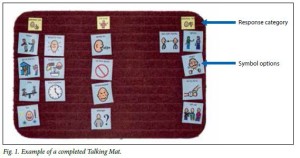
The article’s reference is:
Exploring sibling attitudes towards participation when the younger sibling has a severe speech and language disability. M Hansen, M Harty, J Bornman South African Journal of Child Health 2016 Vol. 10 No. 1
To read the full publication with details of the methods used and the results click here sibling-attitudes-2016
 Online training login
Online training login 

